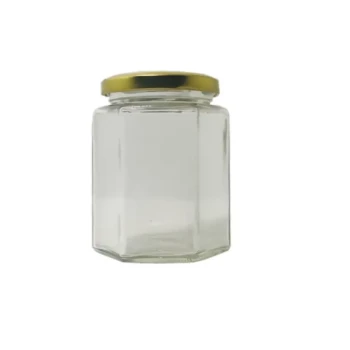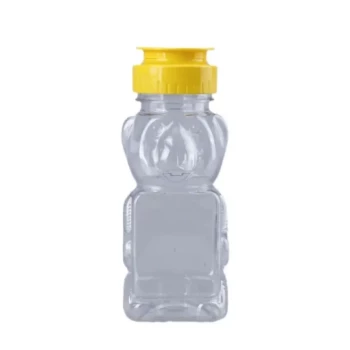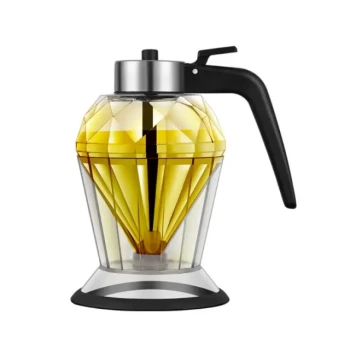The choice of packaging material is the single most critical factor in determining the long-term quality and shelf life of honey. The ideal material creates a perfect barrier against environmental factors. Glass is the superior choice for preservation due to its impermeability, while plastic offers practicality at the cost of being slightly permeable, which can lead to faster crystallization over time.
The core function of honey packaging is to protect it from its three primary enemies: moisture, oxygen, and light. A material's effectiveness is defined by its ability to create an impenetrable barrier against these elements.
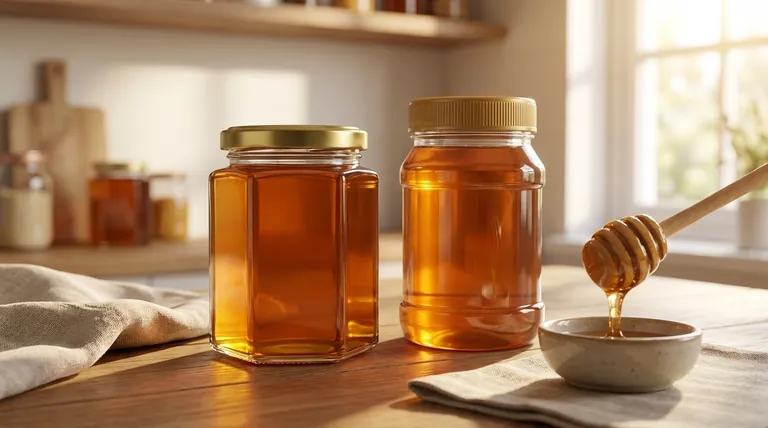
The Core Enemies of Honey Quality
To understand packaging, you must first understand what you are protecting the honey from. Honey is a remarkably stable product, but its quality can degrade if not stored properly.
Moisture: The Catalyst for Degradation
Honey is hygroscopic, meaning it readily absorbs moisture from the air. If the water content rises too high, naturally present yeasts can begin to ferment the honey.
Conversely, some packaging materials can allow moisture to escape, which accelerates the natural process of crystallization.
Oxygen: The Driver of Darkening and Flavor Loss
Exposure to oxygen over long periods can degrade the delicate enzymes and aromas in honey. This oxidative process will also cause the honey to darken in color and can subtly alter its flavor profile.
An airtight seal is non-negotiable for preventing this gradual degradation, regardless of the container material.
Light: The Accelerator of Nutrient Loss
Ultraviolet (UV) light is particularly damaging to honey. It breaks down beneficial enzymes, most notably glucose oxidase, which is responsible for honey's antibacterial properties.
Prolonged light exposure can also negatively impact the flavor and aroma of the honey.
Comparing the Primary Packaging Materials
Each material offers a different level of protection against these environmental threats.
Glass: The Gold Standard for Preservation
Glass is the ideal material for long-term storage because it is completely impermeable. It allows zero transfer of moisture or oxygen, perfectly preserving the honey's original state.
For maximum protection, amber or dark-colored glass is superior as it also blocks UV light, offering a complete defense against all three environmental enemies.
Plastic: The Practical, Cost-Effective Alternative
Plastic containers, typically made from PET, are popular due to their low cost, light weight, and resistance to breakage.
However, plastic is minutely permeable to moisture and gases compared to glass. Over a long shelf life, this can lead to gradual moisture changes that may hasten crystallization. While good for many applications, it is not the optimal choice for multi-year preservation.
Understanding the Trade-offs
Choosing the right packaging requires balancing ideal preservation with practical market realities.
Preservation vs. Practicality
Glass offers unparalleled quality preservation but is heavier, more fragile, and often has higher upfront and shipping costs. Plastic offers durability and cost savings, making it a pragmatic choice for many commercial producers.
The Critical Role of the Seal
The container material is only half the equation. A poor seal will negate the benefits of even the best glass jar. The liner inside the cap must create a truly hermetic, airtight seal to prevent oxygen and ambient moisture from entering.
Visibility vs. Protection
Clear containers offer excellent product visibility, which is a major advantage on a retail shelf. However, this comes at the direct cost of exposing the honey to damaging light. Opaque or dark-colored containers provide vital UV protection but hide the product's natural beauty.
Making the Right Choice for Your Product
Your choice of packaging should be a deliberate decision based on your primary goal.
- If your primary focus is maximum shelf life and premium quality: Use dark or amber-colored glass with a high-quality, airtight seal to provide a perfect barrier.
- If your primary focus is cost, safety, and shipping efficiency: Choose a high-quality, food-grade plastic (like PET), understanding it's best for products with a faster expected turnover.
- If your primary focus is retail shelf appeal: A clear glass jar is an excellent choice, but advise that it be stored in a dark cupboard to preserve its quality after purchase.
Ultimately, effective honey packaging is about choosing the right barrier to protect its value from the moment it's sealed.
Summary Table:
| Packaging Material | Key Characteristic | Impact on Honey Shelf Life |
|---|---|---|
| Glass | Completely impermeable to moisture and oxygen | Gold standard for long-term preservation; best for premium quality |
| Plastic (e.g., PET) | Slightly permeable to moisture and gases | Cost-effective and durable, but may hasten crystallization over time |
| Amber/Dark Glass | Blocks UV light in addition to being impermeable | Provides complete protection against all three enemies: moisture, oxygen, and light |
Protect your honey's quality and extend its shelf life with the right packaging. At HONESTBEE, we supply commercial apiaries and beekeeping equipment distributors with wholesale-focused packaging solutions—from airtight glass jars to durable PET containers—designed to preserve your product’s value. Contact us today to discuss packaging that balances preservation, cost, and market appeal for your specific needs!
Visual Guide
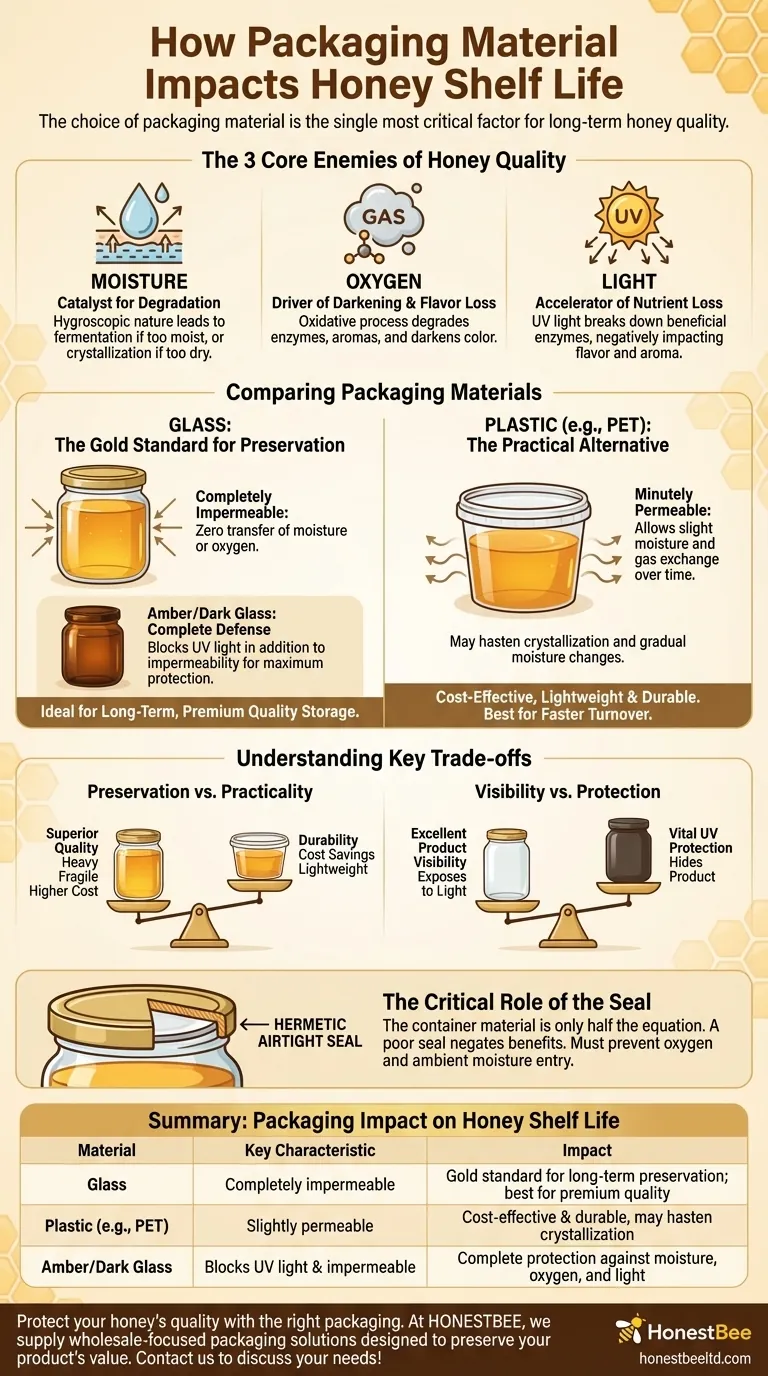
Related Products
- Hexagonal Glass Honey Jars with Metal Lug Caps Elegant Versatile Packaging
- Classic Drum Shaped Glass Honey Jar with Airtight Lid
- Inverted Squeezable Honey Jar with No Drip Flip Top Cap for Easy Pouring
- Classic Honey Bear Jars with Flip Top Dispensing Cap for Liquid Sweeteners
- Pneumatic Double Nozzle Honey Filling Bottling Packaging Machine
People Also Ask
- What are the common types of honey packaging? A Guide to Glass, Plastic, Pouches & Tins
- How should honey be stored and packaged? Preserve Flavor & Quality with Proper Containers
- What are the advantages of using glass jars for honey packaging? Preserve Purity & Elevate Your Brand
- What is the best way to jar honey? Preserve Quality with the Right Container
- What factors should be considered when choosing honey packaging? Optimize for Brand, Operations & Market
